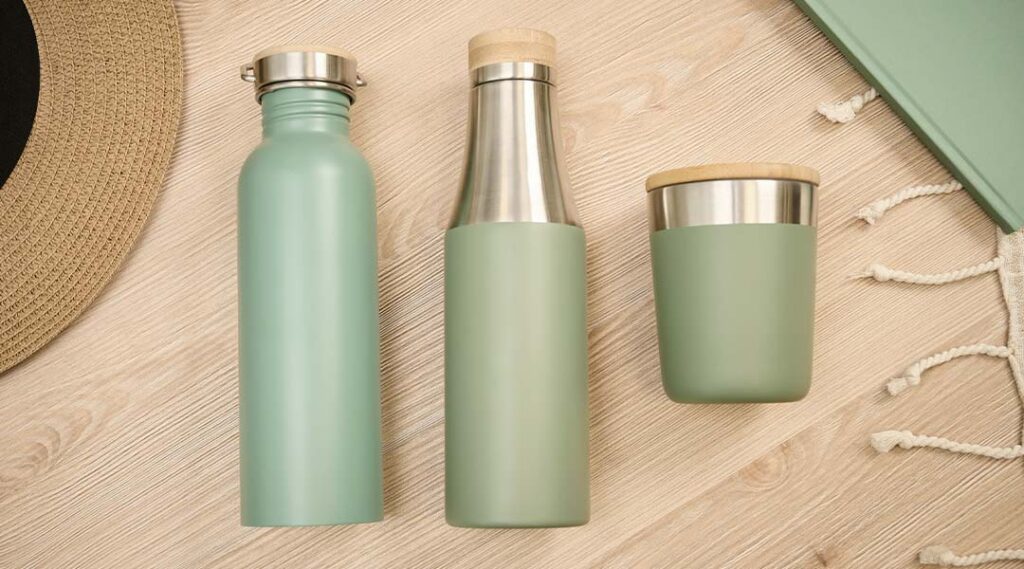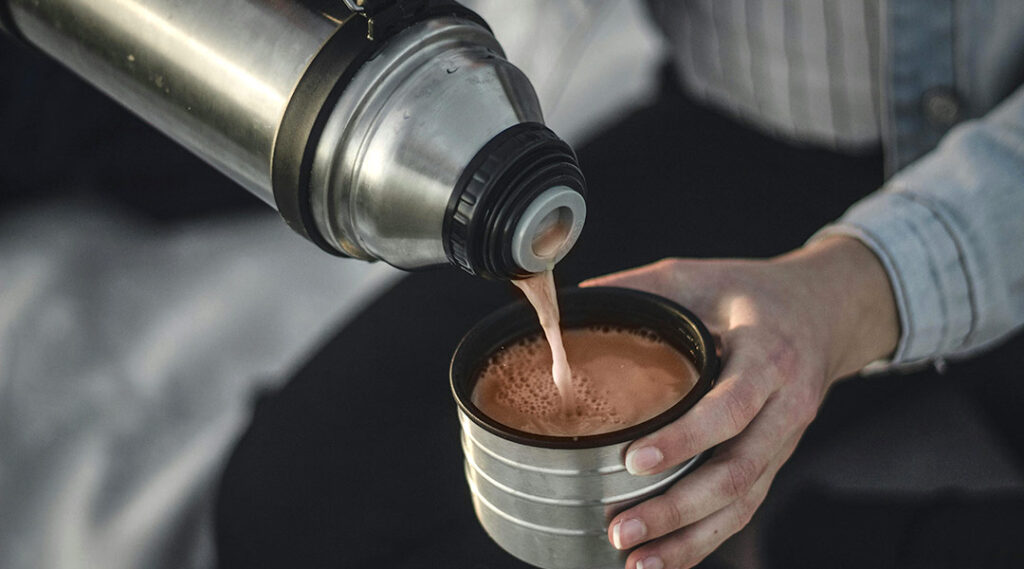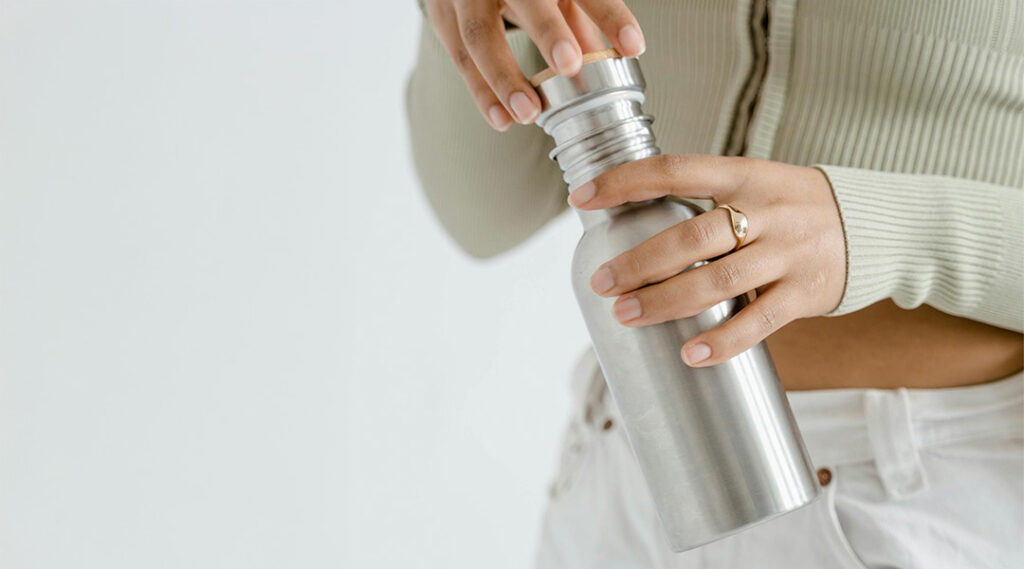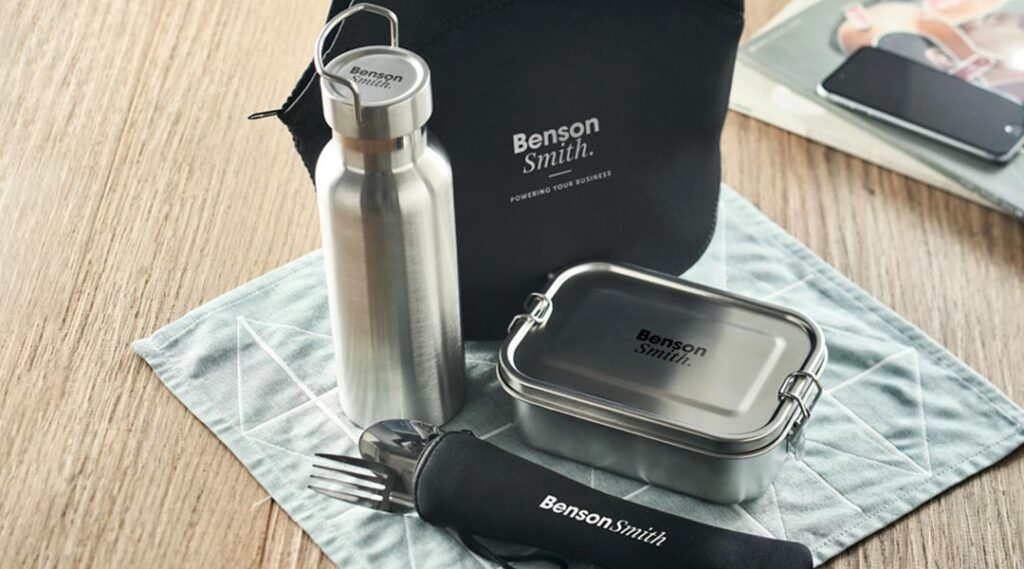
Thermos flasks are specially designed containers that, thanks to thermal insulation, maintain the temperature of beverages for several hours. This technology is not exclusive to thermoses; other products such as mugs, lunch boxes, and even bags also use thermal insulation. Despite being widely used, many people are unaware of how they actually work. So, do you know how a thermos keeps drinks hot or cold? Discover everything you need to know about its functionality.
How Are Thermal Containers Made?
The thermos was invented in 1892 by Scottish chemist and physicist James Dewar. Its effectiveness lies in the combination and arrangement of specific materials, a principle developed through scientific knowledge. Whether in a mug or an insulated bottle, the operating principle remains the same.
What Materials Are Used?
Aluminium, glass, plastic, and stainless steel are the most commonly used materials in the production of insulated containers. Stainless steel is particularly recommended due to its ability to limit heat transfer between the interior and exterior of the container, making it a low thermal conductivity material. Additionally, it is corrosion-resistant, easy to clean, and highly durable.
How Is a Thermos Manufactured?
Thermos flasks are made with a double wall separated by a vacuum, which prevents heat transfer between the inside and outside. This design, based on layering two bottles, creates an insulating barrier that keeps the liquid’s temperature stable, unaffected by the environment. As a result, the thermos exterior remains cool to the touch, even when filled with boiling liquid. This double-wall insulation technology is key to preserving hot or cold liquids for extended periods.
Note: While the thermos walls help maintain the temperature, heat can escape through the lid. To minimise this loss, a sealing ring is incorporated, playing a crucial role in keeping liquids hot or cold.
How Long Does a Thermos Maintain Temperature?

The retention time primarily depends on whether the liquid is hot or cold. However, other factors also influence performance:
Factors Affecting Thermal Retention
- – Quality of insulation: Models with double stainless-steel walls and air gaps provide better thermal retention.
- – Container capacity: The larger the thermos, the longer it retains temperature due to greater thermal mass.
- – Initial temperature of the liquid: If the liquid is introduced at the optimal temperature, it will stay hot or cold for longer.
- – Frequency of opening: Each time the lid is opened, some temperature is lost.
Tip: To maximise efficiency, preheat the thermos with hot water or cool it with ice water before filling it with your drink.
Hot Liquids
A high-quality thermos can retain heat for 6 to 24 hours. Premium models keep beverages hot for up to a full day, while others maintain warmth for around 12 hours.
Cold Liquids
A thermos can keep a drink cold for up to 24 hours, and even longer if ice cubes are added. High-performance models can preserve freshness for up to 48 hours.
How Does a Thermos Keep Drinks Hot?
The purpose of an insulated bottle is to minimise heat transfer to maintain the liquid’s temperature. Heat is transmitted through three physical mechanisms:
- – Conduction
- – Radiation
- – Convection
Thermal Conduction
This occurs when a hot object comes into contact with a colder one, causing heat to flow naturally from the first to the second until thermal equilibrium is reached.
Not all materials conduct heat in the same way. Metals, for instance, are excellent conductors, which speeds up heat dissipation. In a conventional container, heat from the liquid transfers to the container walls and then to the surrounding air. Meanwhile, the external air gradually cools the walls, reducing the beverage’s temperature.
Conversely, an insulated bottle minimises this effect with its double-wall design. The insulation system relies on a vacuum between the inner and outer walls, which limits heat transfer by contact and effectively slows thermal conduction.
Electromagnetic Radiation
Any hot object emits heat in the form of radiation, mainly in the infrared spectrum. This phenomenon is evident with the sun, heated metal that glows red, or even the human body, which emits detectable infrared radiation.
In a thermos, the outer wall reflects radiation from the environment, while the inner wall reduces heat dissipation from the liquid.
Thermal Convection
Heat is not only transferred through direct contact but also through fluids. This is noticeable when you hold your hand over a cup of boiling water and feel the rising hot air. Convection occurs when warm air molecules rise and come into contact with cooler air.
A thermos is designed to minimise this effect. The vacuum between its walls limits the movement of air molecules, thereby reducing heat loss to a minimum.
How Does a Thermos Keep Drinks Cold?

A stainless-steel insulated bottle is designed to maintain the temperature of beverages, whether hot or cold. Its effectiveness is due to several factors:
- – Airtight lid with a seal: Minimises convection and prevents air exchange.
- – Vacuum space between walls: Reduces thermal conduction.
- – Internal metallic layer: Further slows heat transfer.
These elements ensure that heat cannot enter or escape, enhancing thermal efficiency.
Types of Thermos Flasks
Thermal insulation technology is used in various types of containers. Here are some examples:
1. For Beverages
- – Thermoses: Keep drinks hot for 12 to 24 hours and cold for up to 48 hours. Typically feature an airtight cap.
- – Thermal mugs: Compact and practical for daily use, they retain heat for 4 to 8 hours. They often have leak-proof lids and easy-drink openings.
2. Lunch Containers
- – Food boxes: Maintain the temperature of hot or cold meals for 4 to 12 hours, ideal for soups, prepared dishes, or yogurts.
- – Lunch boxes: With compartments, they allow for the organised storage of different food items.
3. Bags
- – Insulated bags: Used for carrying food or drinks in large quantities for picnics, grocery shopping, or lunch transport, maintaining temperature for several hours.
- – Cooler bags: Designed for long-term storage of food and beverages, they can be equipped with cooling blocks and other accessories for greater efficiency.
Personalise Your Thermos with Gift Campaign

At Gift Campaign, you can customise thermoses, water bottles, mugs, lunch boxes, and insulated bags with your logo. We offer over 380 products featuring this technology, keeping drinks and food at the right temperature for hours.
These products serve as an effective communication tool for your marketing and promotional campaigns. You can print them with your corporate image by selecting the colour and printing technique that best suits your brand. Many items are made from stainless steel, allowing for laser engraving, which provides a fine, professional, and durable finish. You can also print your logo in colour using pad printing, digital printing, or screen printing. Some models also offer 360° printing, enabling branding all around the product.
Conclusion
A thermos is much more than just a container—it is based on thermal insulation technology that preserves beverages and food for several hours. Thanks to its double-wall design and the properties of materials like stainless steel, it effectively limits heat transfer through conduction, convection, and radiation. Additionally, whether it’s a mug, a water bottle, or an insulated bag, these products can be personalised. They are an excellent promotional tool for businesses looking to combine practicality with brand visibility.